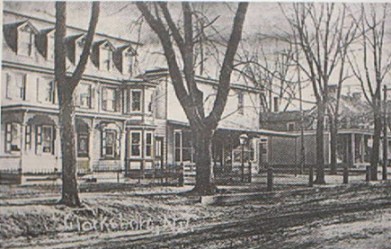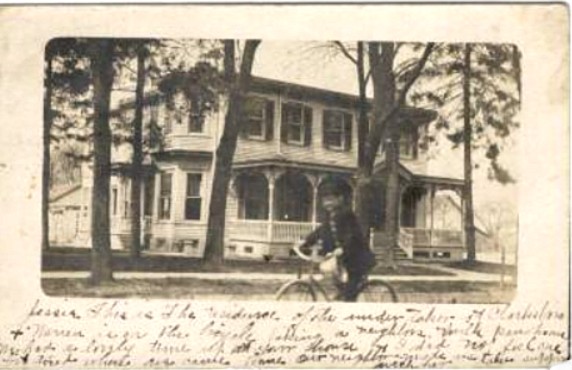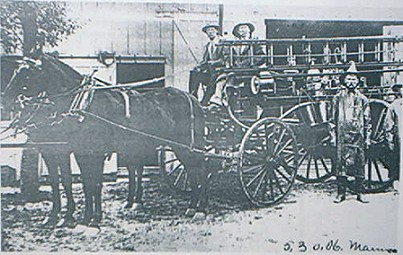|
|
| |
H I S T O R Y o f
C L A R K S B O R O |
Clarksboro (originally called Clarksborough) was settled at the crossing of two
important roads--the Kings Highway and Cohawkin Road. The Swedes,
Finns and Dutch had settlements along the Delaware and local creeks since 1633,
and the Native Americans (Lenni
Lenape) even earlier than that.

Clarksboro intersection at Kings Highway and Cohawkin Road.
Photograph generously donated by Pete Miskofsky
This quiet old town is
situated in the northeast part of the township, at the crossing of Old Salem Pike
and the Paulsboro-Mullica Hill Roads.
In the early part of the present
(19th) century, the land on the northeast side of the Mullica Hill Road was owned
by Jeffrey Clark [genealogy and some descendants of Jeffrey Clark coming
soon], from whom the town takes its name. He was a large landowner, his plantation
including all in that part of and running well up towards the old Death
of the Fox Inn." He caused the farm on that portion nearest the crossing
to be laid out in building lots, somewhat larger than is the custom at the present
day.
READ about the original CLARK FAMILY
burial spot.
The southwest side of the Mullica Hill and Paulsboro
road was owned by different parties, among whom was John Eglington (after whom
Elgingon Cemetery is named), the Gill family, the Sailers, and others.
The town began to grow and in 1824 it had become the great trading point for miles
around... The old Salem turnpike, the milestones of which were set up in 1772-1773,
is the principal street, beautifully shaded... The railroad station is at a crossing
of the Paulsboro road, an on that street, a few houses and a German Church have
been built since the advent of the railroad. Clarksboro has had a post office
since 1827. [Centennial 8, Emma Engle]
 Clark's
Funeral Home in Clarksboro Clark's
Funeral Home in Clarksboro |
According
to some accounts, the name of Clarksboro is probably traceable to John Clark of
London who was one of the creditors of Edward Byllinge and who received a deed
from Byllinge dated July 26, 1681 conveying 1,000 acres of land along Mantua Creek,
500 on the northwest side and 500 on the southwest side of the Creek. This John
Clark died intestate and the land descended to John Clark, Jr. of Hackney, Middlesex
County, England, who conveyed his land in 1702 to Benjamin Alford of New England
in America [Peaslee, A; 18] Some
other early pioneer owners included Francis Austin 1715, Jonathan
Haines 1719, John Eglington prior to 1776, Matty Coats 1799,
James C. Wood 1799.
The pioneer merchant, Matthew Gill,
as early as 1775 was trading in codfish, molasses, nails, calico, brown linen
sheeting, crockery, tea, sugar, rum and other items. For many years this store
was the great center of Clarksboro.  Clarksboro
Hotel pictured in 1946-1947 during reconstruction. Many thanks to John Baughman
of Clarksboro for providing this photograph Clarksboro
Hotel pictured in 1946-1947 during reconstruction. Many thanks to John Baughman
of Clarksboro for providing this photograph | 
Former
Clarksboro Hotel, now apartments | | The
old Gill store on the northwest corner was replaced by a 3-story red brick
building, called the Clarksboro Hotel (see photographs just above). This building
was later painted white and is currently a multi-apartment building. While Matthew
Gill was in the mercantile business he was also engaged in distilling spirits.
His old distillery stood nearly in the rear of this building, or on what is now
the next lot. Here the old pioneer farmers could exchange their corn, rye, and
wheat for something more exhilarating, which many of them did, until it was banned
due to public opinion. |

Clarksboro's first
fire engine with horses, "Starlight," and "Twilight." This
photo
was taken in 1906 in front of Joseph Clark's barn in Clarksboro.
The horses belonged to Clark and pulled the hearse as well as
the fire engine.
Photograph graciously donated by Pete Miskofsky
St.
Peter's Episcopal Church was founded at Berkley [Mt. Royal] in 1770/1771.
Regular services began here in 1824 with Mr. Richard D. Hall. In 1845 The church's
site was moved to Clarksboro. SEE more history and
photographs. Zion
Methodist Church. The first Methodist Episcopal Church built in the state
of New Jersey was at Berkley [Mt. Royal], in 1766. Here Methodism began--in East
Greenwich Township, which was then part of Greenwich Township.In 1834, a church
was built in Clarksboro. SEE more history and photographs.
The Evangelical United Methodist Church was established at Clarksboro
by the Evangelical Association in 1879. SEE more history
and photographs. SEE
a map of Clarksboro's Business Directory of 1860 - showing houses and
their owners. (JPG file) The
original Clarksboro School was
known to have existed in 1876.
The Justice-Peaslee
House was built here circa 1747.
The George
H. Grandfield house was built here circa 1878.
SEE
PHOTOGRAPHS and HISTORIC
HOUSES in Clarksboro.
| |

